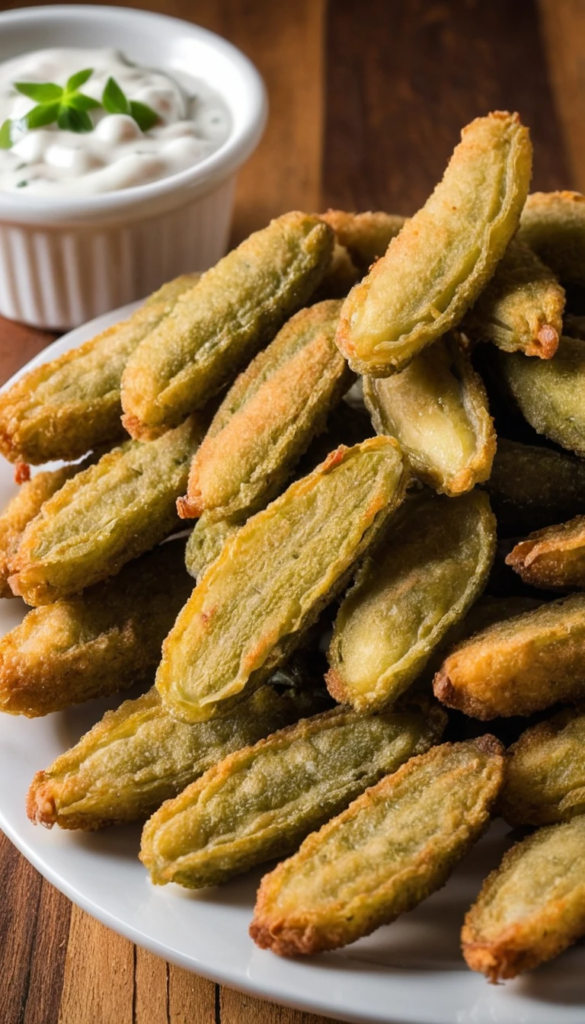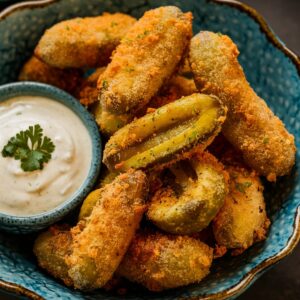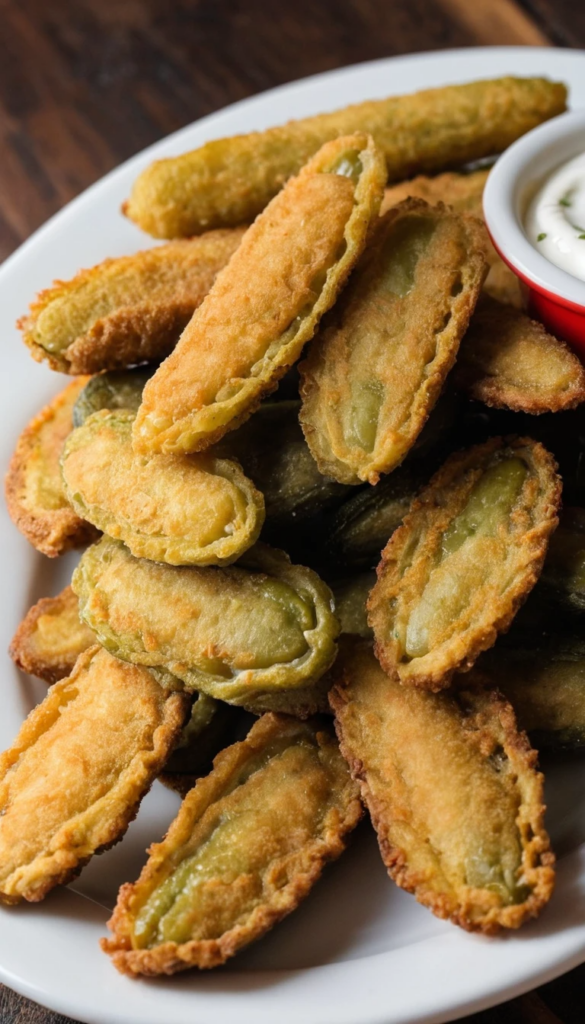Texas Roadhouse Fried Pickles are a popular appetizer known for their crispy, tangy, and flavorful bite. Made from thinly sliced dill pickles, they are hand-battered in a seasoned coating and deep-fried to a golden brown.

The result is a crunchy exterior that perfectly complements the juicy, zesty pickle inside. Served hot and fresh, these fried pickles come with a side of creamy ranch dressing or Cajun horseradish sauce for dipping, adding a cool and zesty contrast to the crispy texture. This fan-favorite appetizer is perfect for sharing and delivers a satisfying combination of crunch, saltiness, and bold flavor.
Texas Roadhouse Fried Pickles Recipe
This step-by-step guide will help you recreate the famous Texas Roadhouse Fried Pickles at home. These crispy, tangy, and perfectly seasoned pickles are easy to make and great for sharing!
Ingredients:
For the Pickles:
- 1 jar (16 oz) dill pickle chips (or sliced pickles)
- 1 cup all-purpose flour
- 1 teaspoon paprika
- 1 teaspoon garlic powder
- 1 teaspoon onion powder
- 1 teaspoon cayenne pepper (adjust for spice level)
- 1 teaspoon black pepper
- 1 teaspoon salt
- ½ teaspoon dried oregano
- ½ teaspoon baking powder (for crispiness)
- ½ cup buttermilk
- 1 large egg
- 1 cup cornmeal (optional, for extra crunch)
- Vegetable oil (for frying)
For the Dipping Sauce:
- ½ cup mayonnaise
- 2 tablespoons ketchup
- 1 teaspoon prepared horseradish
- ½ teaspoon paprika
- ½ teaspoon garlic powder
- ½ teaspoon cayenne pepper (optional)
- 1 teaspoon lemon juice
- Salt & pepper to taste
Step-by-Step Instructions:
Step 1: Prepare the Pickles
- Open the jar of dill pickle chips and drain them completely.
- Lay the pickles on a paper towel-lined plate and pat them dry with another paper towel. Removing excess moisture is crucial for a crispy coating.
- Let them sit for about 10 minutes to remove more moisture while you prepare the batter.
Step 2: Make the Dipping Sauce
- In a small bowl, mix together:
- ½ cup mayonnaise
- 2 tablespoons ketchup
- 1 teaspoon horseradish
- ½ teaspoon each of paprika, garlic powder, and cayenne pepper
- 1 teaspoon lemon juice
- Salt and pepper to taste
- Stir well until smooth, then cover and refrigerate while making the pickles.
Step 3: Heat the Oil
- Pour about 2 inches of vegetable oil into a deep skillet or heavy-bottomed pot.
- Heat the oil to 350°F (175°C) using a kitchen thermometer. If you don’t have one, test by dropping a small bit of flour into the oil—if it sizzles immediately, the oil is ready.
Step 4: Prepare the Breading Station
- In a shallow bowl, whisk together the dry ingredients:
- 1 cup flour
- 1 teaspoon each of paprika, garlic powder, onion powder, cayenne pepper, black pepper, and salt
- ½ teaspoon each of dried oregano and baking powder
- 1 cup cornmeal (optional, for extra crunch)
- In a separate bowl, whisk together:
- ½ cup buttermilk
- 1 large egg
Step 5: Coat the Pickles
- Working in small batches, dip the pickles into the buttermilk mixture, ensuring they are fully coated.
- Transfer the wet pickles into the flour mixture, tossing them to coat completely. Press gently to ensure the breading sticks well.
- Shake off any excess flour before frying.
Step 6: Fry the Pickles
- Carefully place a few coated pickles into the hot oil using tongs. Do not overcrowd the pan.
- Fry for about 2-3 minutes, flipping halfway, until they turn golden brown and crispy.
- Remove with a slotted spoon and place on a paper towel-lined plate to drain excess oil.
- Repeat with the remaining pickles, allowing the oil to return to 350°F between batches.
Step 7: Serve and Enjoy!
- Transfer the crispy fried pickles to a serving platter.
- Serve immediately with the homemade dipping sauce on the side.
- Enjoy the crispy, tangy, and flavorful Texas Roadhouse-style fried pickles!
Pro Tips for Perfect Fried Pickles:
✅ Dry the pickles well – Excess moisture can make the coating soggy.
✅ Use buttermilk for flavor & texture – It helps the breading stick better.
✅ Fry in small batches – Overcrowding lowers oil temperature and results in greasy pickles.
✅ Keep oil at 350°F – Too hot, and the outside burns; too cool, and they get oily.
✅ Eat fresh – Fried pickles taste best when served immediately!

Fried Pickles Recipe
Equipment
- Deep fryer or large heavy-bottomed pot
- Slotted spoon or tongs
- Paper towels
- Large mixing bowl
- Whisk
- Baking sheet
- Cooling rack
Ingredients
- 1 cup dill pickle slices
- 1 cup all-purpose flour
- 1 teaspoon garlic powder
- 1 teaspoon onion powder
- 1 teaspoon paprika
- 1 teaspoon salt
- 1/2 teaspoon black pepper
- 1/2 teaspoon cayenne pepper (optional, for heat)
- 1 teaspoon buttermilk
- Vegetable oil (for frying)
Instructions
- Preparation: Heat oil in a deep fryer or large pot to 375°F (190°C).
- Dry Pickles: Pat the pickle slices dry with paper towels to remove excess moisture.
- Mix Dry Ingredients: In a large bowl, whisk together the flour, garlic powder, onion powder, paprika, salt, black pepper, and cayenne pepper (if using).
- Coat Pickles: Dip the pickle slices in buttermilk, then dredge them in the seasoned flour mixture, making sure they are well coated.
- Fry Pickles: Carefully place the coated pickles in the hot oil using a slotted spoon or tongs. Fry in batches to avoid overcrowding, for about 2-3 minutes or until golden brown and crispy.
- Drain: Remove the fried pickles and place them on a baking sheet lined with paper towels to drain excess oil.
- Serve: Transfer to a cooling rack for a minute to maintain crispiness. Serve hot with ranch dressing or your favorite dipping sauce.
Notes
Tips/Notes
- Dry the Pickles: Ensuring the pickles are dry before coating helps the batter stick better and results in a crispier finish.
- Temperature Control: Maintain the oil temperature at 375°F. Too low, and the pickles will be greasy; too high, and they might burn.
- Seasonings: Adjust the seasoning in the flour mixture to your taste. Add more cayenne for extra spice.
- Alternative Coatings: For a different texture, try using panko breadcrumbs instead of flour.
- Dipping Sauce: Ranch is classic, but spicy aioli or blue cheese dressing are great alternatives.
![Texas Roadhouse Specials Menu Prices [Early Bird + Lunch]❤️](https://texasroadhousespecials.com/wordpress/wp-content/uploads/2025/04/TEXAS-2.png)
